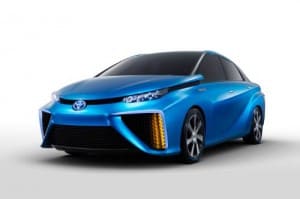 Toyota is showing two new cars of the future at CES, using hyrdrogen fuel cell technology.
Toyota is showing two new cars of the future at CES, using hyrdrogen fuel cell technology.
The FCV concept car demonstrates what the four-door mid-size sedan will look like in Radiant Blue; and the camouflage-taped engineering prototype used for extensive and extreme on-road testing in North America for more than a year.
The prototype has consistently delivered a driving range of about 300 miles, zero-to-sixty acceleration of about 10 seconds, with no emissions, other than water vapor. Refueling of its hydrogen tanks takes three to five minutes.
Toyota claims hydrogen works beautifully with oxygen to create water and electricity and nothing more.
Since 2002, Toyota has been testing and developing a series of prototypes in North America. Toyota estimates a 95-percent cost reduction in the powertrain and fuel tanks of the vehicle it will launch in 2015.
A fully-fueled vehicle will be capable of supplying enough energy to power a house for a week in an emergency
The cares will be launched in California. Toyota has partnered with the University of California Irvine’s Advanced Power and Energy Program (APEP) to help map out potential locations for new hydrogen fueling stations.
The connected part of the car is the need to fund hydrogen re-fueling stations before the “gas” runs out.
Already, California has approved more than $200 million in funding to build about 20 new stations by 2015, a total of 40 by 2016, and as many as 100 by 2024. To help guide the construction of new stations, the APEP model is being used by:
- the California Energy Commission,
- the Governor’s Zero Emission Vehicle Initiative,
- the California Air Resources Board,
- the U.S. Department of Energy
- and the California Fuel Cell Partnership.